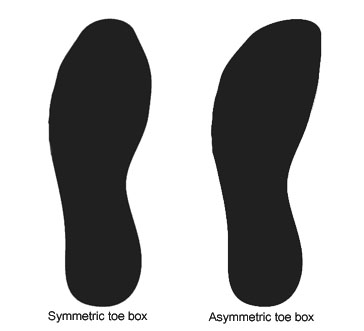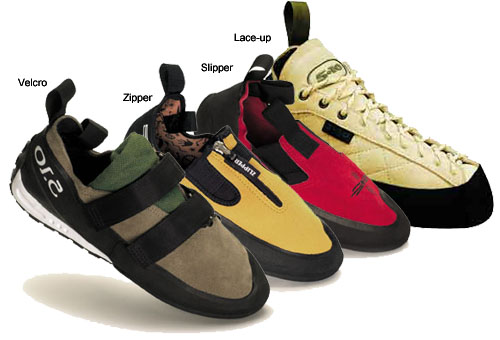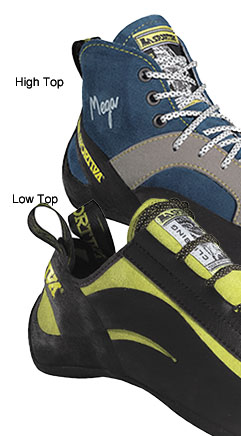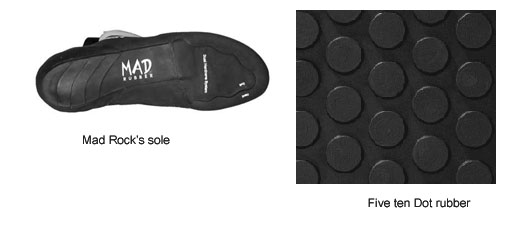

The most important piece of personal gear that you will own is a pair of shoes. Shoes constitute half of your interface with the rock. There are many different factors to consider when you are buying a pair of shoes. Theses factors include fit, brand, symmetry, toe box shape, last style, heel design, type of rock you climb on, style of climbing you do, experience at climbing, amount of money you can spend, height of the shoe and stiffness.
A shoe last is the form that is foot shaped that the shoe is built around. The shape of the last determines the shape of the shoe. There are two ways that climbing shoes are built on a last. The first way is the shoe upper is sewn then slipped on to the last, called slip lasted. The other way is for the shoe to be built off of a board that is placed on the last, called board lasted. Since the board is usually made of leather, fiber board or plastic, the board lasted shoes tend to be a lot stiffer and a lot less sensitive than slip lasted shoes. This can be a big advantage if you are spending a lot of time on pointy foot holds, or cramming your foot into a crack. This can be a problem if you are having to do a lot of smearing or trying to feel for a micro hold that you can't see. Most board lasted shoes are more comfortable so they are great for long all day climbs. Examples of board lasted shoes are La Sportiva Mega and Boreal Equinox. Most shoes you buy will be slip lasted.
The shape of the last is also very important. You will usally hear about two terms when it comes to shape, symmetry and camber.
Symmetrical shoes have the front toe point in the middle. This is an old, very general design, but it still fits people with long middle toes and short big toes! Rock shoes are now becoming more asymmetrical where the shape follows the anatomy of the foot and the front point is over the big toe. If your big toe is the longest this is what you need.
Camber is how much the last turns down. Some climbing shoes have a sharp down turn while others are almost as flat as street shoes.
The more cambered and asymmetrical a shoe is the more uncomfortable it will feel. Most climbers will eventually get used to the shoe bending the foot around. I shudder to think what a Podiatrist would say about climbers and their shoes.


Climbing shoes need to fit tight. Lateral tightness is more important than length tightness. With no socks on, the shoe should lace or strap tight enough that your foot feels squeezed across the ball of the foot. There is huge amounts of debate about the toe fit. Some feel that your toes should be forced into a curled position so that they are pushing down into the tip of the shoe. Others feel that the toe should nearly be crammed up to the front of the shoe, but not bent. Different toe boxes will allow your toes to stay down or curl. If you get a shoe with a sling shot heel it should fit with your heel all the way to the back of the shoe. This will probably hurt on the toe end. I have had climbers tell me they choose shoes that they can keep on for about ten minutes before the pain becomes un-bearable. I no longer buy my shoes this tight. One time at Red Rock I dropped one of my shoes from the 9th pitch of a climb because I was having to take them off at the end of every pitch. (I know, I should have clipped a sling to them,) I would recommend a comfortable fit board lasted shoe if you are doing multi pitch climbs, and a toe busting foot killing slipper if you are bouldering. Gym and sport shoes should fit tight, without too much pain.

The rand is the rubber part that comes up around the toe and sides of the shoe. (Or even up on top like the Mad Rock Hooker) The rand is important if you are doing a lot of crack climbing. If you are primarily doing sport or gym climbing you will only need a toe and heel rand. Heels of climbing shoes can be molded, relaxed, or tensioned. The tensioned heels are called slingshot heels and will have the rand made of a stretchy rubber that is pulled tight across the heel. These types of heels will cram your foot into the toe of the shoe and they keep the shoe fitting tight even after it has stretched some. Molded heels will also push your foot to the front of the shoe, but not as actively as the tensioned heels. Relaxed heels are molded to the shape of the shoe, and do very little to force the foot forward. Generally tensioned shoes are harder to put on and take off, and hurt more than other types of heels.

How the shoe goes on your foot can be important for several reasons. All uppers stretch some as you use the shoe. Some unlined leather uppers can stretch a full size when you start sweating in them. Slippers have no way of tightening if they stretch out of shape. Slippers need to be fitted extremely tight to when you buy them. This means all kinds of pain. Slippers are the lightest type of shoes since there is very little material in them. Most slippers will have a velcro tab or a single velcro strap. Laces allow the shoe to be fine tuned to your foot. Laces should go all the way to the toe. Laces have the advantage that they are a dependable way to tighten a shoe onto your foot. The obvious draw backs are broken laces, and untied shoes. Lace up shoes will always have the best fit. Velcro slippers are a compromise and they can fit almost as well as lace ups. Most velcro closures will have two to four straps at various angles. They are not true slippers since they are more like a shoe, with a tongue and stuff than they are like true slippers. I have never owned Zipper shoes. It seems like a really bad Idea to me.

At one point in time all climbing shoes were high tops, climbers wore spandex, and people listened to to Duran Duran. Then came the ninety's and people started buying low cut shoes, wearing normal clothing to climb in and listening to other bubble gum pop. I still use a set of high tops for climbing on granite. I hate to have the balls of my ankles filling my shoes with blood because they have no skin left on them. If you like doing foot jams in cracks, then a good set of Sportiva Megas will save your ankles. For inside the gym and limestone or sand stone, I prefer shorter shoes that are easier to smear with.

Where the rubber meets the rock. This is where it all happens. The whole rest of the shoe is simply a fancy way to hold the rubber onto your feet. Five ten have the best sole, and Madrock has the stickiest. Most climbing shoes have smooth flat soles. A couple of exceptions to this are the dot rubber that Five Ten puts on the heels of sme models and the hybrid sole that Mad Rock uses.

| Country |
Price Range |
Sole |
Kid shoe |
| USA |
Spire $90 Dragon $160 |
C4, HF proprietary |
No |
| Country |
Price Range |
Sole |
Kid shoe |
| Italy |
Cliff $99 Testarossa $160 |
Vibram XSV |
Yes- Junior $70 |
| Country |
Price Range |
Sole |
Kid shoe |
| Spain |
$95-$140 |
Fusion 3 |
Yes- Ninja Jr. $65 |
| Country |
Price Range |
Sole |
Kid shoe |
| USA |
Phoenix $62 Hooker $90 |
Hybrid |
No |
| Country |
Price Range |
Sole |
Kid shoe |
| Germany |
$100-$140 | Vibram XSV | No |
| Country |
Price Range |
Sole |
Kid shoe |
| France |
$70-$130 | APM, DPM | Yes- Monkey $55, Baboon $75 |
| Country |
Price Range |
Sole |
Kid shoe |
| USA |
$89-$115 | TRAX™ XT-5 | No |
| Country |
Price Range |
Sole |
Kid shoe |
| Italy |
$100-$140 | Mega Byte | No |
| Country |
Price Range |
Sole |
Kid shoe |
| Switzerland | Tusk $95 Extreme $149 |
SF 64 | No |
| Country |
Price Range |
Sole |
Kid shoe |
| Spain | $87-$105 | Vibram Grip | No |
| Country |
Price Range |
Sole |
Kid shoe |
| China | $69-$90 | Vibram | Yes-Spider Jr. $59 |